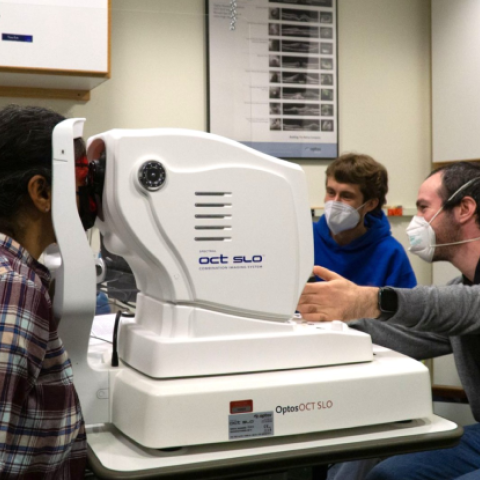
- Principal Investigator:
- Christopher Tyler

- Principal Investigator:
- Lora Likova
Recent studies have established that a high proportion of patients diagnosed with mild (or diffuse) traumatic brain injury (mTBI) exhibit binocular vision dysfunctions, particularly, deficiencies in the binocular coordination of eye movements. Such a loss of coordination may result in deficits which have pronounced negative impact on their ability of estimating distance to targets in depth, tracking moving vehicles, reading and other activities of high civilian and military importance, and on the quality of life in general. Effective treatment of these oculomotor problems requires accurate diagnosis of the source of the problem. However, oculomotor control involves a incompletely understood complex of brainstem, subcortical and cortical pathways, any of which may be disrupted by TBI. Severe brain injury is often visible by structural brain imaging, such as X-radiography or magnetic resonance imaging (MRI). However, milder effects that are invisible to these techniques may nevertheless cause severe oculomotor disruptions in mTBI.
Brainstem Effects in mTBI. The basis of this proposal is the recently established result that what was previously considered to be diffuse brain trauma does in fact have a focal effect centered on the brainstem. The main forms of impact that produced concussion in such head impacts are oblique impacts that caused shear stresses and neural damage in the upper brainstem, precisely the region of the main oculomotor control nuclei for binocular coordination (as inferred from monkey studies and human brain injury cases). This analysis led us to the novel hypothesis that functional imaging in the oculomotor brainstem and cerebellum pathways of the mTBI patients should provide the needed insight into the nature of the deficit that is persistently clouding their lives. We have recently been successful in making the first imaging measurements of oculomotor activation in the brainstems of humans (or any other species). This breakthrough will allow us to test this hypothesis with innovative studies of the functional losses in each oculomotor nucleus in the brains of the mTBI patients. We will also determine the eye movement capabilities with extensive measurements of both the dynamics of the eye movements and the way the two eyes work together in a large control population for evaluation of this behavior in the group of mTBI patients.
Relation to Health Care Needs. The control of the ocular convergence or divergence of the viewing axes of the two eyes (or, more generally, vergence control) is a generally under-rated visual capability, although it is critical for maintaining the single percept of the separate images from the two eyes (Strube & Büttner, 2007). When vergence control is disrupted, we have the confusing “double vision”, or diplopia, of perceiving the two separate images overlaid on each other, making it difficult to read, watch television drive, coordinate visually-guided hand movements, and so on. Since there are two images of everything, we no longer know which is the ‘true’ object, disrupting the sense of the space around us and the locations of the objects within it. Disorders of binocular vision thus have a severe impact on most of the activities of everyday life (until the visual system is able to adapt by assigning one eye’s view as the dominant image and blocking out or suppressing the other image). However, this process may take months or years in the adult brain, so the typical TBI patient would face a considerable period of such ocular disturbance if left untreated.
Potential Impact. The potential impact of the current proposal in understanding the specific locations of brain injury in visual dysfunctions associated with mTBI in both the military and civilian populations is extremely significant. Currently clinical interventions for such visual dysfunctions are controversial and guided by untested hypotheses and clinical trial and error studies (USGA, 2008). It is well documented, however, that these dysfunctions have a profoundly negative impact on both the ability of performing military or other professional duties and on the quality of daily living. The development of successful diagnostics, medical treatments and rehabilitation must be guided by a detailed understanding of the brain injury which causes the dysfunctions. This proposal will provide the first accurate knowledge of the oculomotor pathways in the human brainstem and their functional and structural changes in mTBI patients. Thus the proposed study will not only provide new scientific knowledge, but this knowledge will have a huge potential for the development of non-invasive biomarkers for mTBI.

